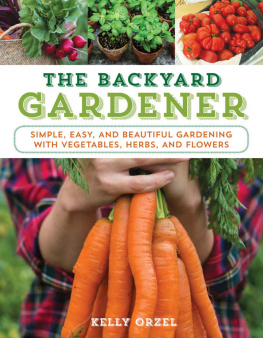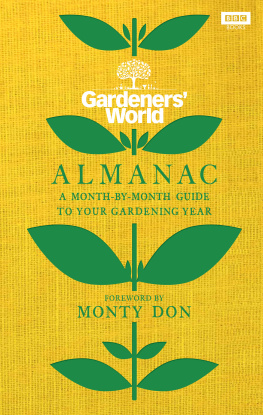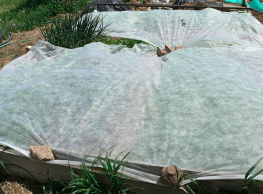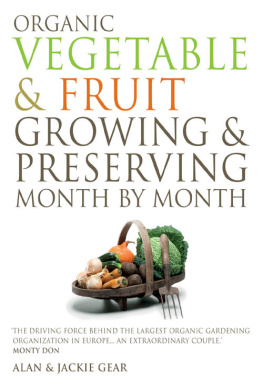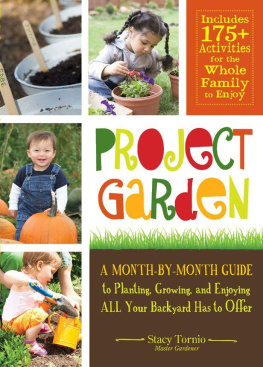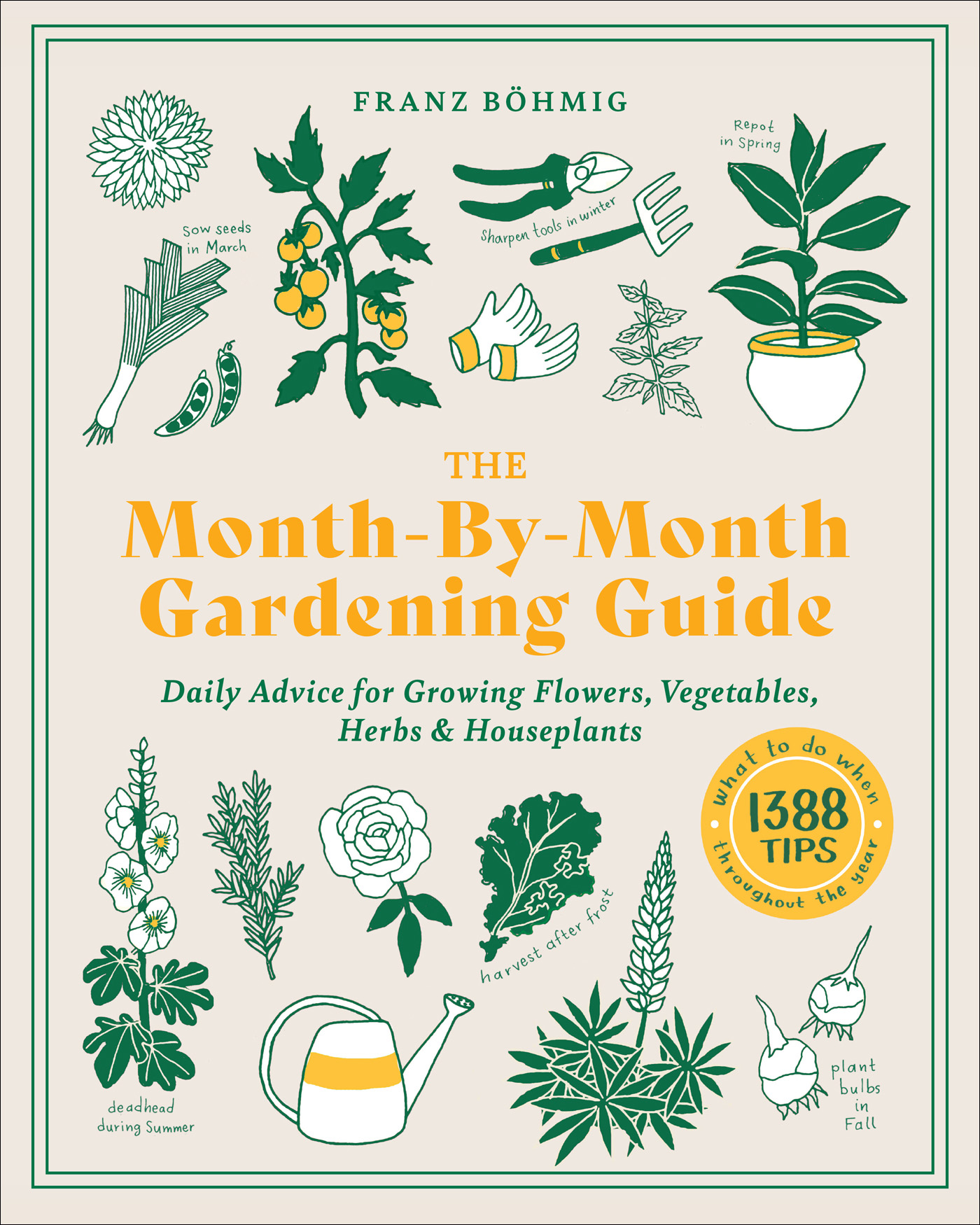Contents
Guide
Page List
THE
Month-By-Month
Gardening Guide
Daily Advice for Growing Flowers,
Vegetables, Herbs & Houseplants
FRANZ BHMIG
Translated by Michael Ashdown

FOREWORD
With his informative and easy-to-understand tips, Franz Bhmig laid the foundation for this book more than 50 years ago. Since then, it has become an established standard reference work: the 28th edition was an anniversary edition, and the book was then revised further with the 29th edition, which featured a greater emphasis on nature and environmental conservation. We now present the 30th edition, translated into English for the first time.
Nearly 1400 tips and a wealth of sound advice will help gardening enthusiasts plan more attractive gardens, try their hand at growing new vegetable species, and take special maintenance measures into consideration when growing traditional varieties. The requirements of a garden and its use have changed in recent years, and so the 29th edition included many new vegetable and ornamental plant varieties in addition to those which were well known in Bhmigs day.
Meanwhile, a greater emphasis has been given on how a contribution to maintaining the diversity of our native fauna and flora can be made in even the smallest gardens. Today, most gardening enthusiasts are aware of their responsibilities in this regard. They have recognized that our native animals and plants need to be protected, and that establishing a near-natural garden can offer an ideal habitat in which these organisms can thrive. They know, too, that implementing biological pest control methods in the house and garden is wiser in the long run than immediately resorting to chemical means. Accordingly, it has also been important to give advice on how plant pests and diseases can be combated using natural methods. Similarly, tips have been added on how to plan a near-natural garden without having to forego the pleasures of double-flowering rose cultivars or splendid lilies.
To continue to be able to enjoy the diversity and beauty of nature in our gardens in the future, it is helpful to prune died-off plant stalks and seed heads not in the fall, but only later, in the springthese will then provide a home for many useful insects during the winter. Meanwhile, hedgehogs can overwinter in small piles of leaves or brushwood in a shady, sheltered corner, while a piece of deadwood can help wild bees and beetles (and their larvae) to survive.
Greenhouses or glasshouses, meanwhile, have a different significance now than they did many years ago, when issues of supply from the garden were much more important. Today, greenhouses are primarily used to grow healthy vegetables without the use of pesticides or artificial fertilizers.
Balconies, terraces, and winter gardens enable us to relax and take pleasure from our plants, regardless of whether they are winter hardy or need to overwinter in a frost-free environment. All the associated problems have been sufficiently noted and appropriate advice given. Other tips, such as those regarding soil cultivation, for example, have been brought in line with the current state of knowledge. This also applies to the issue of peat: it has long been known that further unchecked peat extraction may lead to the downfall of our wetlands. Accordingly, the book contains tips on how peat can be used effectively and alternatives to consider.
By employing the right measures at the right time, plant growth and flowering can be fully optimized and fruiting enhanced, yielding a richer harvest and greatly enhancing the enjoyment of our plants and gardens. Accordingly, attaining a beautiful and bountiful garden and taking pleasure in our plants remains the central focus of this book. It shows how the necessary work can be made easier to manage, and that this represents just a minor outlay for considerable pleasure and enjoyment, which is enhanced still further by outstanding yields.
A note on plant names: in the tips and tables, the botanical (Latin) names of the plants are given in addition to the English plant names, because the English designations can vary greatly from region to region, which can lead to confusion. Every now and then, the botanical name of a species needs to be changed. This is often necessary because of genetic studies and the concomitant new findings. As a rule, the older name that is no longer valid, but represents a synonym, is also given in parentheses. Since taxonomists are not always in agreement when it comes to renaming, it is necessary to determine which publication should be used as a basis for the botanical names. For this book, we have largely followed the new Zander: Erhardt, W., E. Gtz, N. Bdeker, and S. Seybold; 2014: Zander: Dictionary of Plant Names, 19th edition, Verlag Eugen Ulmer, Stuttgart, Germany.
Brbel Rth, Flarchheim, Spring 2018


ABOUT THIS BOOK
First of all, readers should be aware that this book is divided into two main parts. The first part comprises the tips themselves, which contribute to good plant growth, flowering, and rich yields in the garden. For better orientation, these are subdivided into the following sections:
Winter
Spring
Summer
Fall
The second part comprises special tables and lists of vegetable and ornamental plant varieties, with indications of their soil requirements, planting times, planting widths, and more. Additionally, the tips for the gardening year from January to December are subdivided according to the following headings:
General
Vegetables
Ornamental Plants
Ornamental Gardens
Terraces and Balconies
Winter Gardens, Flower Windows, and Rooms
Since the topic of ornamental plants is extensive, ranging from flowerbeds in the garden to plants in the house, in windows, on the terrace and balcony, and in winter gardens, the tips in this section have been further subdivided accordingly. This means that important tasks relating to ornamental plants in all areas can be carried out at the optimal time.
Within the individual tips themselves, readers will find specific techniques, advice, and recommendations for successful gardening and plant cultivation.
The illustrations associated with the individual tips explain the tasks, working methods, and work sequences in more detail. Cross-references (for example ) refer to tips elsewhere that contain information on the same subject, and that should be noted as well. Sometimes, references are also made to a table in the second part of the book.
The second part of the book consists of tables that provide detailed information on the individual topic areas, with specific plant species and varieties. Here you will find listings of ornamental plants such as trees and shrubs, winter-hardy perennials, creepers, and climbers, as well as aquatic plants, grasses, and ferns, and, not least, indoor plants. Many vegetable varieties are listed too, along with their specific soil and climate requirements. Among other things, you can find information in the individual tables on site and environmental conditions, maintenance measures, growth forms, fruit sizes, development times, and harvesting tips, as well as on pests that attack our vegetable and ornamental plants. This second part, too, follows the same General Vegetables Ornamental Plants sequence. These tables will provide gardening enthusiasts with a wealth of knowledge to enable them to enjoy a rich harvest through the lively and healthy growth of their plants.





